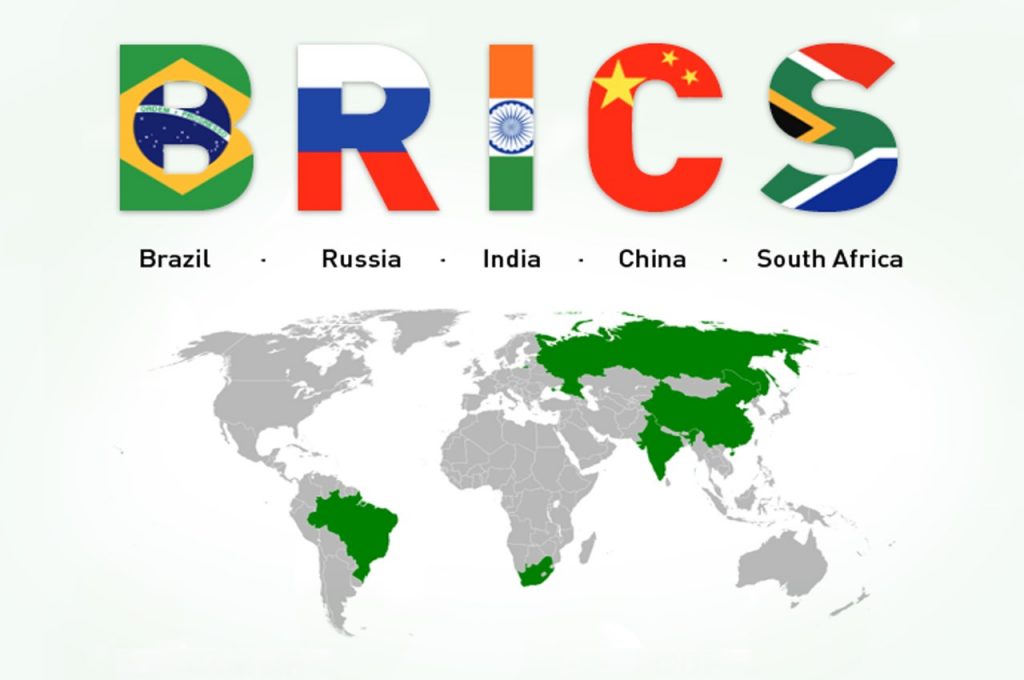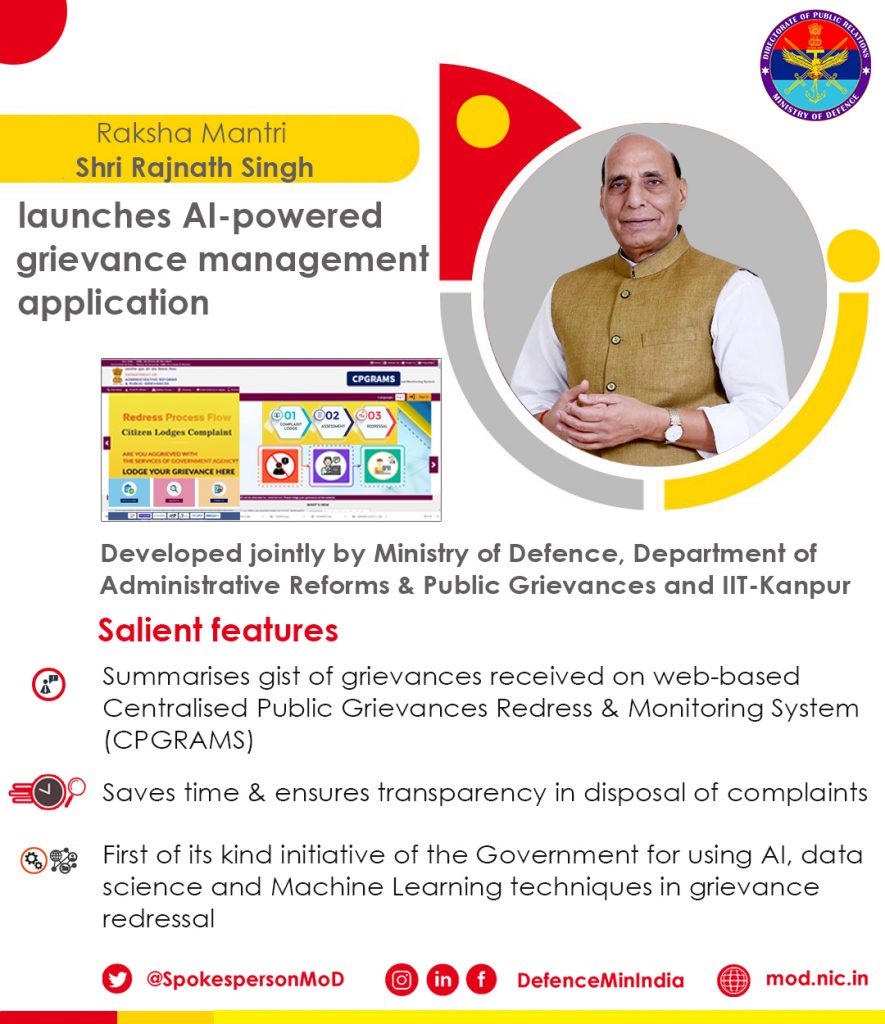CONTENT
- COVID TEEKA SANG SURAKSHIT VAN, DHAN AUR UDDYAM
- PILGRIMAGE REJUVENATION AND SPIRITUAL, HERITAGE AUGMENTATION DRIVE (PRASHAD)
- 7TH BRICS LABOUR AND EMPLOYMENT MINISTERS MEETING
- ARTIFICIAL INTELLIGENCE POWERED GRIEVANCE MANAGEMENT APPLICATION
- DRAFT DRONE RULES 2021
COVID TEEKA SANG SURAKSHIT VAN, DHAN AUR UDDYAM
Focus: GS III- Government Policies and Interventions
Why in News?
Minister of Tribal Affairs virtually launched the nationwide campaign “COVID Teeka Sang Surakshit Van, Dhan aur Uddyam” to accelerate the pace of COVID vaccination among tribals in India.
About COVID Teeka Sang Surakshit Van, Dhan aur Uddyam:
- The campaign will leverage the 45,000 Van Dhan Vikas Kendras (VDVK) of the Tribal Co-operative Marketing Development Federation of India (TRIFED), a national level cooperative body under the administrative control of Ministry of Tribal Affairs, Government of India.
- The campaign is being launched in partnership with UNICEF and WHO.
- The goal is to connect over 50 lakh tribals emphasizing COVID-19 vaccination is free, available in the nearby centres and it not only protects people from hospitalization cost and death but also helps to continue with livelihood activities.
- The campaign will leverage the strength and network of Self Help Groups and other common touch points – Common Service Centres, fertilizers outlet centres, Haats and Bazaars, VDVKs and milk collection points, and will use wall paintings with tribal motifs to promote vaccine uptake and COVID Appropriate Behaviour.
- The campaign will use non-traditional partnerships and community reach for mobilization and collective action such as involvement of traditional leaders like tadvis/patels, faith-based healers and incentivize adoption of vaccines through local health structures and COVID warriors.
- The campaign hopes to make our Van Dhan Vikas Kendras and villages to be the first in respective states to be declared COVID free and free of all restrictions.
- The ‘COVID Teeka Sang Surakshit Van, Dhan aur Uddyam’ campaign focusses on reassurance, pride and self-efficacy.
- It promotes ‘Livelihoods with Health’ in tribal areas, fast tracks the activities of VDVK, and accelerates the pace of COVID vaccination among tribals engaged in procurement, value addition and marketing of handlooms, handicrafts and forest produces
The campaign will highlight the three key Js:
- Jeevan (Life) – Every life and livelihood is precious, so vaccination is key to life and is free.
- Jeevika (Livelihood) – You can continue with your Van Dhan Vikas Kendra and livelihood activities without any fear of getting the disease if you are vaccinated. It also saves you from hospitalization and other opportunity costs.
- Jaagrookta (Awareness) – Simplification of the process of registration for vaccination, place, accessibility to different audiences and age groups, especially women and elderly population. Van Dhan Vikas Kendras collaborate and work with other stakeholders with service as a motto and with dedication and commitment that they have a key role to make Panchayats and villages coronavirus free.
PILGRIMAGE REJUVENATION AND SPIRITUAL, HERITAGE AUGMENTATION DRIVE (PRASHAD)
Focus: GS I- Indian culture.
Why in News?
Prime Minister inaugurated various development projects in Varanasi which includes Tourist Facilitation Centre under the Project “Development of Varanasi Under PRASHAD Scheme – Phase II” and operation of Cruise Boat from Assi Ghat to RajGhat under the Project “Development of River Cruise in Varanasi under PRASHAD Scheme”.
About PRASAD SCHEME
- The ‘National Mission on Pilgrimage Rejuvenation and Spiritual Augmentation Drive’ (PRASAD) was launched by the Ministry of Tourism in the year 2014-15 with the objective of holistic development of identified pilgrimage destinations.
- The name of the scheme was changed from PRASAD to “National Mission on Pilgrimage Rejuvenation and Spiritual, Heritage Augmentation Drive (PRASHAD)” in October 2017.
- After the discontinuation of the HRIDAY scheme of the Ministry of Housing and Urban Development, the development of Heritage destinations was included in the PRASAD Scheme, changing it to PRASHAD.
- Pilgrimage Rejuvenation and Spiritual Augmentation Drive (PRASAD) is a Central Sector Scheme that focuses on identifying and developing the pilgrim sites across the country to enrich the religious tourism experience. It was launched by the Ministry of Tourism.
- The Ministry of Tourism provides Central Financial Assistance (CFA) to State Governments for promoting tourism at identified destinations. For components within public funding under this scheme, Central Government will provide 100% fund.
- For improved sustainability of project, it also seeks to involve Public Private Partnership (PPP) and Corporate Social Responsibility (CSR) as well.
Objectives of PRASHAD Scheme
- It wants to Harness pilgrimage tourism for its direct and multiplier effect upon employment generation and economic development.
- It Enhances tourist attractiveness in sustainable manner by developing world class infrastructure in the religious destinations.
- It also seeks to promote local art, culture, handicraft, cuisine, etc.
- It Strengthen the mechanism for bridging the infrastructural gaps.
- It follow community based development and create awareness among the local communities.
Below are the 12 cities initial chosen under PRASHAD Scheme
Kamakhya (Assam),
Amaravati (Andhra Pradesh)
Dwaraka (Gujarat),
Gaya (Bihar),
Amritsar (Punjab),
Ajmer (Rajasthan),
Puri (Odisha),
Kedarnath (Uttarakhand)
Kanchipuram(Tamil Nadu)
Velankanni (Tamil Nadu),
Varanasi (Uttar Pradesh),
Mathura (Uttar Pradesh).

7TH BRICS LABOUR AND EMPLOYMENT MINISTERS MEETING
Focus: GS II- International relations
Why in News?
Union Minister for Labour & Employment chaired the BRICS Labour & Employment Ministers Meeting under India’s Presidency.
Key Highlights:
- India organized the BRICS Labour & Employment Ministers’ Meeting to exchange views on the impact of Covid-19 on global labour market, enhance information sharing, discuss and agree upon specific areas of cooperation between BRICS Member countries.
- Discussion on four priority areas of cooperation took place namely, Promoting Social Security Agreements amongst BRICS Nations; Formalisation of Labour Markets; Participation of Women in the Labour Force; and Gig and Platform Workers: Role in the Labour Market.
- The significant aspect of the meeting was the adoption of the BRICS Labour & Employment Ministers’ Declaration.
- The Ministerial Declaration recognized that the COVID-19 pandemic has negatively impacted the efforts made to address unemployment, decent work deficits and inequality.
- It also illustrates the strong determination of BRICS Member countries to recover with stronger national economies, inclusive labour markets and social protection systems.
About BRICS

- BRICS is an informal group of Brazil, Russia, India, China and South Africa (joined in 2010).
- The BRICS leaders’ summit is convened annually.
- BRICS does not exist in form of organization, but it is an annual summit between the supreme leaders of five nations.
- The Chairmanship of the forum is rotated annually among the members, in accordance with the acronym B-R-I-C-S.
- Together, BRICS accounts for about 42% of the world’s population and about 23% of the global GDP (Gross Domestic Product), and 17% of the world trade, making it a critical economic engine.
- The five nations account for 50 per cent of the world economic growth, 27% of the world area and 13.24% of World Bank voting power.
- Pitted as a counterweight to G7, the combine of developed economies, BRICS represents the world’s top emerging economies and claims to serve as a bridge between the developed and developing world.
ARTIFICIAL INTELLIGENCE POWERED GRIEVANCE MANAGEMENT APPLICATION
Focus: GS II- Governance
Why in News?
Defence Minister launched an Artificial Intelligence (AI)-powered grievance management application in New Delhi.
About Artificial Intelligence (AI)-powered grievance management application:
- It is developed by Ministry of Defence with the help of IIT-Kanpur.
- This is the first AI based system developed to improve grievance redressal in the Government.
- The AI tool developed as part of the initiative has capability to understand the content of the complaint based on the contents therein. As a result, it can identify repeat complaints or spam automatically.
- Based on the meaning of the complaint, it can categorise complaints of different categories even when key words normally used for such search are not present in the complaint.
- It enables geographical analysis of complaints in a category including analysis of whether the complaint was adequately addressed or not by the concerned office.
- Easy user-friendly search enables user to formulate his own queries/categories depending on management requirements and seek performance results based on the query.
- The release of this application marks the introduction of AI-based innovations into governance and administration.
- This project is first of its kind initiative of the Government for using AI, data science and Machine Learning techniques in grievance redressal. The success of this project in MoD will pave the way for extension of this application across other Ministries.

DRAFT DRONE RULES 2021
Focus: GS II- Government Policies and Interventions
Why in News?
Ministry of Civil Aviation (MoCA) has released the updated – The Drone Rules, 2021 for public consultation. Built on a premise of trust, self-certification, and non-intrusive monitoring, The Drone Rules, 2021 will replace the UAS Rules 2021 (released on 12 March 2021).
Key takeaways from the Draft Drone Rules, 2021 include:
- Approvals abolished: unique authorisation number, unique prototype identification number, certificate of conformance, certificate of maintenance, import clearance, acceptance of existing drones, operator permit, authorisation of R&D organisation, student remote pilot licence, remote pilot instructor authorisation, drone port authorisation etc.
- Number of forms reduced from 25 to 6.
- Fee reduced to nominal levels. No linkage with the size of the drone.
- Safety features like ‘No permission – no take-off’ (NPNT), real-time tracking beacon, geo-fencing etc. to be notified in future. A six-month lead time will be provided for compliance.
- Digital sky platform shall be developed as a business-friendly single-window online system.
- There will be minimal human interface on the digital sky platform and most permissions will be self-generated.
- Interactive airspace map with green, yellow, and red zones will be displayed on the digital sky platform.
- Yellow zone reduced from 45 km to 12 km from the airport perimeter.
- No flight permission required upto 400 feet in green zones and upto 200 feet in the area between 8 and 12 km from the airport perimeter.
- No pilot licence required for micro drones (for non-commercial use), nano drone and for R&D organisations.
- No restriction on drone operations by foreign-owned companies registered in India.
- Import of drones and drone components to be regulated by DGFT.
- No security clearance required before any registration or licence issuance.
- No requirement of certificate of airworthiness, unique identification number, prior permission and remote pilot licence for R&D entities.
- Coverage of drones under Drone Rules, 2021 increased from 300 kg to 500 kg. This will cover drone taxis also.
- All drone training and testing to be carried out by an authorised drone school. DGCA shall prescribe training requirements, oversee drone schools and provide pilot licences online.
- Issuance of Certificate of Airworthiness delegated to Quality Council of India and certification entities authorised by it.
- Manufacturer may generate their drone’s unique identification number on the digital sky platform through the self-certification route.
- Easier process prescribed for transfer and deregistration of drones.
- Standard operating procedures (SOP) and training procedure manuals (TPM) will be prescribed by DGCA on the digital sky platform for self-monitoring by users. No approvals required unless there is a significant departure from the prescribed procedures.
- Maximum penalty under Drone Rules, 2021 reduced to INR 1 lakh. This shall, however, not apply to penalties in respect of violation of other laws.
- Drone corridors will be developed for cargo deliveries.
- Drone promotion council to be set up to facilitate a business-friendly regulatory regime.




